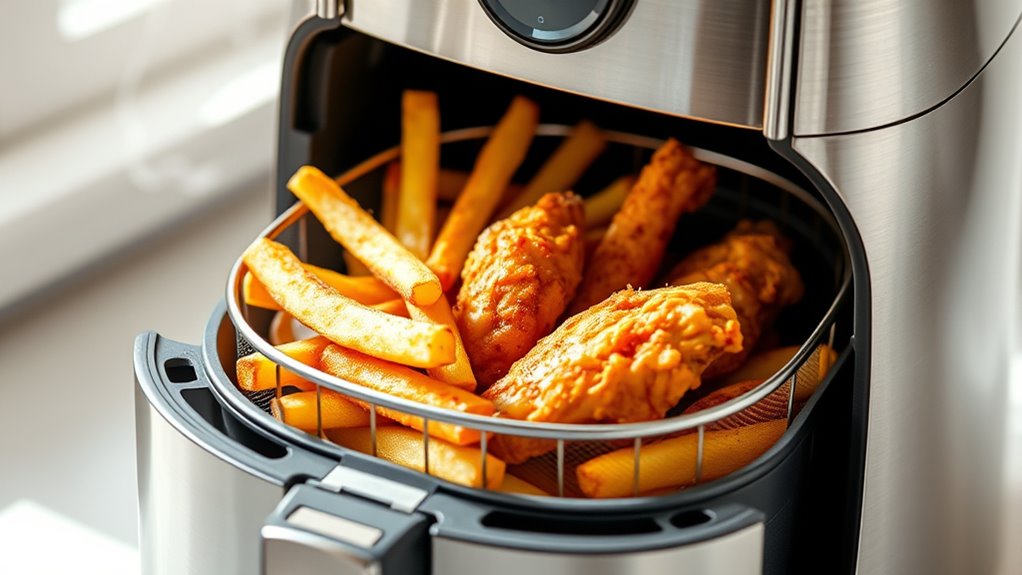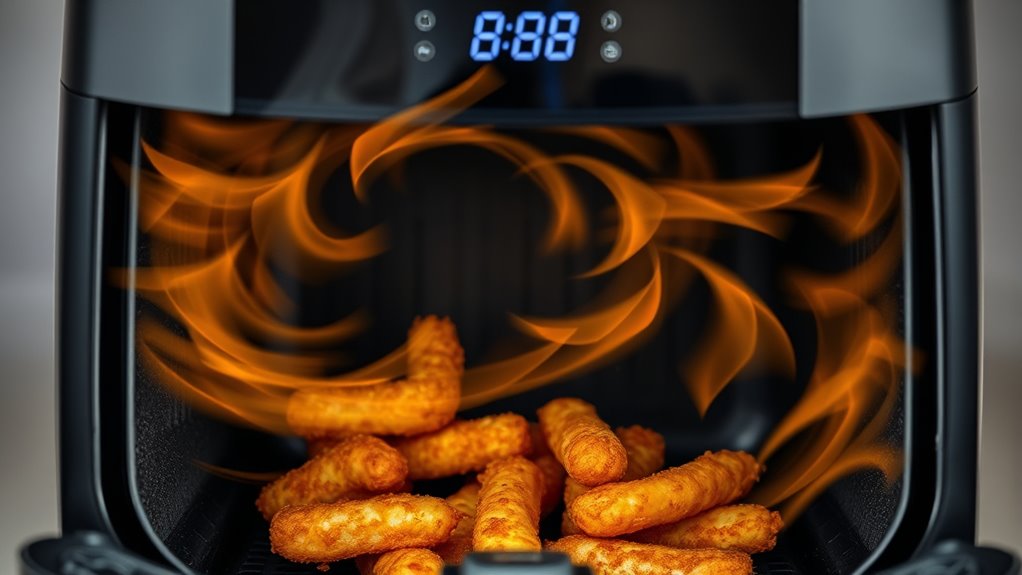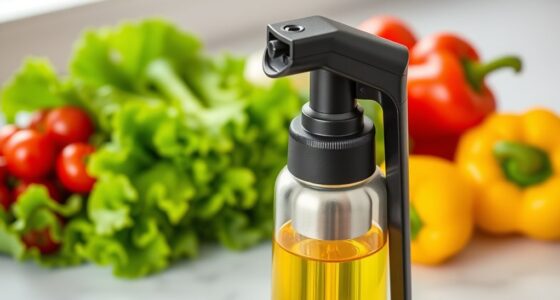Air frying works by circulating hot air rapidly around your food, creating a dry, high-temperature environment that browns and crisps foods similarly to deep-frying. By using minimal oil, it softens the moisture on the surface, promoting browning through Maillard reactions. This process reduces fat intake and calories while still delivering that crispy texture you love. If you’re curious about how this innovative method achieves such results and why it’s healthier, keep exploring the science behind it.
Key Takeaways
- Air frying uses rapid circulation of hot air to cook and crisp food, mimicking deep frying with less oil.
- The Maillard reaction occurs at high temperatures, browning food and enhancing flavor without excessive fat.
- Controlled hot air flow creates a dry environment that removes moisture, resulting in a crunchy exterior.
- Using minimal oil improves texture and flavor while significantly reducing calorie and unhealthy fat intake.
- Proper technique, including preheating and moderate temperatures, ensures even cooking and healthier, crispy results.
What Is Air Frying and How Does It Differ From Traditional Frying

Air frying is a cooking method that uses hot air circulation to prepare food with little to no oil, making it a healthier alternative to traditional frying. The air fryer history dates back to the early 2000s, gaining popularity as a convenient way to enjoy crispy foods without excess fat. While it mimics deep frying’s results, air frying safety is essential—ensure proper use, avoid overfilling, and keep appliances clean to prevent hazards. Unlike traditional frying, which submerges food in oil, air frying relies on circulating hot air to cook and crisp food evenly. This method reduces oil consumption and mess while delivering similar textures. By understanding its background and safety tips, you can enjoy delicious, healthier meals with confidence.
The Role of Hot Air in Achieving Crispiness

Hot air is the key to achieving that satisfying crispiness in air frying. As the hot air circulates rapidly around your food, it creates a dry, high-temperature environment that promotes the Maillard reaction—browning that enhances texture and flavor. This process helps form a crispy outer layer without the need for excess oil. The consistent flow of hot air removes moisture from the surface, making your food crunchy and golden. By controlling the temperature and airflow, you can fine-tune the level of crispiness you desire. Unlike traditional frying, which relies on submerging food in oil, hot air achieves a similar crispy exterior through evaporation and dehydration, making your meals healthier while maintaining that coveted crunch. Additionally, high-temperature environments are essential for optimal Maillard reactions, further improving texture and flavor.
The Mechanism Behind Rapid Air Circulation

The rapid circulation of hot air in an air fryer is driven by a powerful fan that continuously pushes air around the cooking chamber. This air circulation ensures even heat distribution, which is essential for crispy, well-cooked results. The fan’s speed can usually be adjusted, allowing you to control how quickly the hot air moves. Higher fan speeds increase air circulation, speeding up cooking and promoting uniform browning. Conversely, lower speeds may be used for gentler cooking. This constant movement of hot air creates a convection effect, mimicking the traditional oven but much faster. By maintaining consistent air circulation, the air fryer efficiently transfers heat to your food’s surface, resulting in that desirable crispiness and tender interior. Additionally, natural materials like metal and ceramic components can enhance heat transfer efficiency, contributing to better cooking outcomes.
The Use of Small Amounts of Oil for Texture and Flavor

Adding a small amount of oil can make your food crispier and more appealing. It also enhances the flavor, giving dishes a richer taste. Plus, using less oil helps you enjoy the benefits of air frying without the extra calories. Incorporating proper oil quantity ensures optimal texture and health benefits.
Enhances Crispy Texture
Using small amounts of oil during air frying can considerably improve the crispy texture of your foods. The oil helps create a golden, crunchy exterior by promoting even browning and crispness. To maximize this effect, you might use seasoning techniques that include a light brush or spray of oil, ensuring an even coating. If you prefer oil alternatives, options like cooking sprays or emulsions can also boost crispiness without excess fat. Properly applying oil helps break down surface proteins and enhances caramelization, resulting in a satisfying crunch. Keep in mind that too much oil can make foods greasy, so a light touch is best. Additionally, understanding how heat transfer works in air frying can help you optimize cooking times and achieve better results. With the right method, your air-fried dishes will achieve that perfect, crispy texture everyone loves.
Boosts Flavor Depth
Incorporating small amounts of oil during air frying not only improves texture but also considerably enhances the depth of flavor in your dishes. A light coating of oil helps seasoning techniques work more effectively, allowing spices and herbs to adhere better and release their full aroma. This process facilitates flavor infusion, where the oil acts as a carrier, distributing flavors evenly throughout the food. By using just a touch of oil, you activate Maillard reactions more efficiently, creating richer, more complex taste profiles. This subtle addition amplifies natural flavors without adding excess fat, making your meals more satisfying. Ultimately, the controlled use of oil unleashes deeper layers of flavor, elevating your air-fried dishes to a new level of deliciousness. Proper oil use also plays a crucial role in maintaining equipment performance and longevity, ensuring consistent results over time.
Reduces Oil Content
By using only small amounts of oil, you can achieve a desirable crispy texture and rich flavor without the excess fat often associated with traditional frying. This minimal oil use not only reduces overall oil content but also improves air quality by producing fewer smoke particles and fumes. Since less oil heats up, your air fryer heats faster, enhancing cooking speed and efficiency. The reduced oil layer allows hot air to circulate more evenly around your food, creating crispiness without the greasy mess. As a result, you enjoy healthier meals with less fat and fewer calories. Plus, the cleaner cooking environment minimizes lingering odors and smoke, making air frying a more pleasant and faster cooking option overall. Additionally, understanding the fundamentals of sound design can help you optimize the operation and efficiency of your appliances through better acoustic feedback and noise reduction.
How Air Fryers Mimic Deep-Frying Results

Air fryers achieve deep-frying results primarily through rapid circulation of hot air that creates a crispy outer layer, similar to traditional frying. This process guarantees that food develops a golden, crunchy exterior while remaining tender inside. To maintain these results, proper air fryer maintenance is essential—regular cleaning prevents residue buildup that can affect cooking quality. When trying new air frying recipes, keep in mind that the even heat distribution contributes to consistent crispiness. Unlike deep-frying, you don’t need large quantities of oil; instead, a light coating or spray helps mimic that fried texture. This combination of hot air circulation and minimal oil allows you to enjoy familiar, crispy dishes without the mess or excess fat associated with traditional frying. For optimal performance, regularly checking and cleaning filters can improve airflow and ensure consistent results air purifier maintenance.
The Impact of Reduced Oil on Nutritional Content

Reducing the amount of oil in air frying considerably impacts the nutritional profile of your meals. Oil reduction means you consume fewer calories and less unhealthy fat, making your dishes healthier overall. Since less oil is used, nutrient preservation becomes easier, helping retain vitamins and minerals that can be lost during traditional frying. This process also prevents the formation of harmful compounds associated with excessive oil use. By cutting back on oil, you’re not only lowering fat intake but also improving the quality of your food’s nutritional content. This makes air frying a smart choice for healthier eating habits. Overall, reduced oil use enhances nutrient preservation, allowing you to enjoy delicious, crispy foods without compromising your diet’s nutritional integrity.
Common Misconceptions About Air Frying’s Health Benefits

Many people believe that air frying automatically makes their meals healthy, but this isn’t always the case. Myth busting reveals common misconceptions about its health benefits. Just because you’re using an air fryer doesn’t mean all foods are low-calorie or nutritious.
Using an air fryer doesn’t automatically make your meals healthy or low-calorie.
- Using processed foods or excessive breading still adds unhealthy fats and calories
- Over-relying on air frying can lead to high salt intake if not careful
- Not all “healthier” recipes are low in sugar or sodium
- Air frying doesn’t eliminate the need for balanced, nutrient-rich meals
- Additionally, the health impact of air frying can be influenced by food choices and cooking techniques, emphasizing the importance of a comprehensive approach to healthy eating.
Understanding these misconceptions helps you make informed choices and corrects false perceptions about air frying’s health benefits. It’s a useful tool, but it’s not a magic bullet for health.
Tips for Maximizing Health Benefits When Using an Air Fryer

To get the most health benefits from your air fryer, start by choosing wholesome ingredients like fresh vegetables and lean proteins. Make sure to use proper cooking techniques, such as avoiding excessive oil and setting the right temperature. These simple steps can help you enjoy delicious, healthier meals with your air fryer. Additionally, using air purification technology in your home can further improve indoor air quality, reducing airborne allergens and odors that may affect respiratory health.
Choose Healthy Ingredients
Choosing the right ingredients is essential for maximizing the health benefits of air frying. When selecting foods, focus on nutrient-dense options and consider ingredient substitutions that reduce added fats and sugars. Proper meal planning helps you incorporate healthier ingredients consistently. To boost your meals, try these tips:
- Opt for lean proteins like chicken or fish instead of processed meats
- Use whole grains such as quinoa or brown rice instead of refined grains
- Include plenty of vegetables for fiber and antioxidants
- Swap out high-calorie toppings for herbs, spices, or lemon juice
- Incorporate aquatic exercise to complement a healthy diet and improve overall wellness.
Use Proper Cooking Techniques
Using proper cooking techniques is key to maximizing the health benefits of your air fryer. Start by adjusting the cooking temperature to avoid overcooking or burning foods, which can produce harmful compounds. Use appropriate seasoning techniques by opting for herbs, spices, and natural flavorings instead of excess salt or sugar. This enhances taste without sacrificing health. Keep portions moderate to prevent overeating and ensure even cooking. Preheat your air fryer to the recommended temperature for your recipe, which helps achieve crispy results with less oil. Regularly check food during cooking to prevent over- or under-cooking. Additionally, selecting the right cooking techniques can help preserve nutrients and reduce the formation of unhealthy compounds. By mastering these techniques, you optimize nutrient retention, minimize unhealthy compounds, and enjoy healthier, flavorful meals with your air fryer.
Frequently Asked Questions
Does Air Frying Produce Harmful Compounds Like Acrylamide?
You might wonder if air frying produces harmful compounds like acrylamide. While some chemical safety concerns exist, air frying generally reduces acrylamide formation compared to traditional frying. Since it cooks food at lower temperatures and uses less oil, it minimizes the risk of creating this potentially harmful compound. Overall, air frying offers a safer alternative, but it’s still good to prevent overcooking or burning your food to ensure better chemical safety.
Can Air Frying Replace All Traditional Cooking Methods?
You might wonder if air frying can replace all traditional cooking methods. While it offers excellent cooking versatility and preserves flavor well, it may not suit every dish or technique. For complex recipes or large quantities, traditional methods like baking or boiling might be better. But for quick, healthier options with crispy textures, air frying is a convenient choice. It complements your cooking toolkit without fully replacing your other methods.
How Does Air Frying Impact Calorie Content Compared to Deep-Frying?
Did you know air frying can cut calories by up to 70% compared to deep-frying? When you use an air fryer, you markedly reduce fat content because it uses little to no oil. This calorie reduction helps you enjoy crispy foods without the guilt. So, if you’re aiming for healthier meals, air frying offers a smarter way to satisfy your cravings while keeping your calorie intake in check.
Are There Specific Foods That Don’t Cook Well in an Air Fryer?
You might find that frozen items, like breaded chicken or fries, cook well in your air fryer, but delicate pastries may not turn out as expected. Their thin, flaky layers can get too crispy or burn easily. So, you should be cautious when air frying fragile foods. Adjust cooking time and temperature, and consider using parchment paper or a tray to prevent sticking or over-browning.
What Are the Environmental Benefits of Using an Air Fryer?
Using an air fryer benefits the environment by promoting sustainable energy and eco-friendly cooking. It uses less electricity than traditional ovens, reducing your carbon footprint. Its efficient design minimizes food waste and saves time, decreasing energy consumption overall. By choosing an air fryer, you support greener habits, helping to conserve resources and reduce pollution. This way, you make a positive impact on the environment while enjoying healthier, delicious meals.
Conclusion
Remember, Rome wasn’t built in a day, and mastering air frying takes time. By understanding how hot air crisps your favorite foods with less oil, you’re making smarter, healthier choices. So, keep experimenting and don’t be discouraged by misconceptions. With patience and practice, you’ll enjoy delicious, crispy meals that are better for you. After all, small steps lead to big changes—embrace the science behind air frying and savor the benefits!









